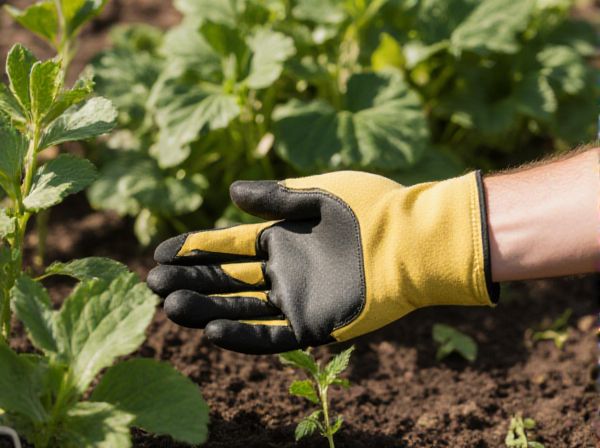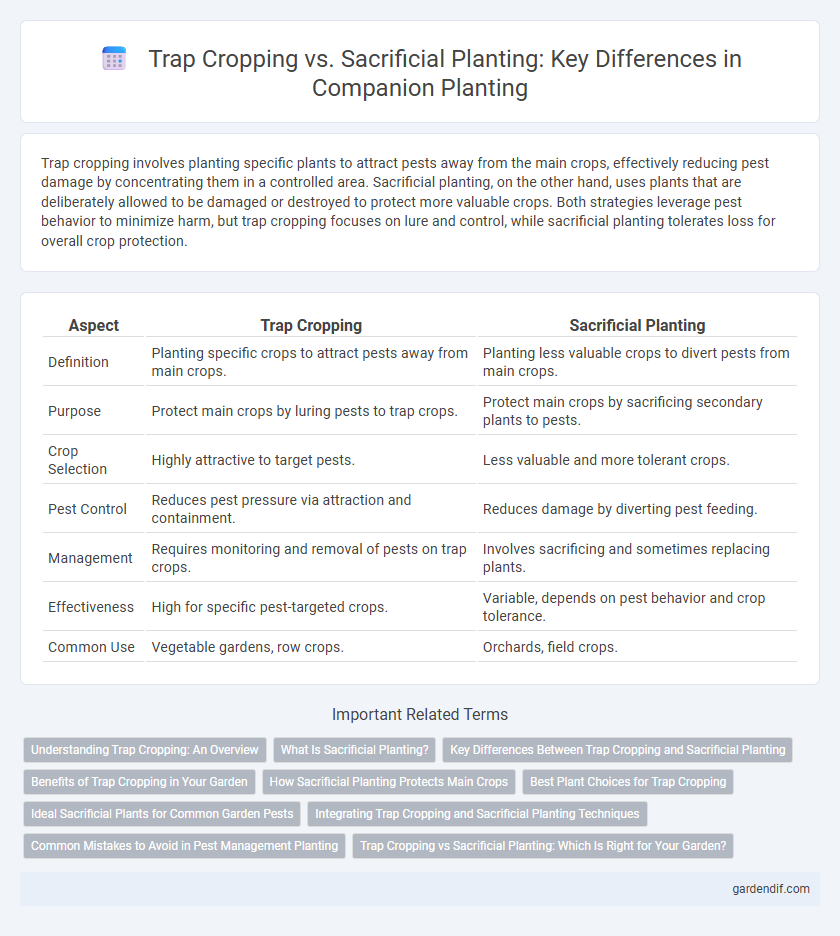
Trap Cropping vs Sacrificial Planting Illustration
Trap cropping involves planting specific plants to attract pests away from the main crops, effectively reducing pest damage by concentrating them in a controlled area. Sacrificial planting, on the other hand, uses plants that are deliberately allowed to be damaged or destroyed to protect more valuable crops. Both strategies leverage pest behavior to minimize harm, but trap cropping focuses on lure and control, while sacrificial planting tolerates loss for overall crop protection.
Table of Comparison
| Aspect | Trap Cropping | Sacrificial Planting |
|---|---|---|
| Definition | Planting specific crops to attract pests away from main crops. | Planting less valuable crops to divert pests from main crops. |
| Purpose | Protect main crops by luring pests to trap crops. | Protect main crops by sacrificing secondary plants to pests. |
| Crop Selection | Highly attractive to target pests. | Less valuable and more tolerant crops. |
| Pest Control | Reduces pest pressure via attraction and containment. | Reduces damage by diverting pest feeding. |
| Management | Requires monitoring and removal of pests on trap crops. | Involves sacrificing and sometimes replacing plants. |
| Effectiveness | High for specific pest-targeted crops. | Variable, depends on pest behavior and crop tolerance. |
| Common Use | Vegetable gardens, row crops. | Orchards, field crops. |
Understanding Trap Cropping: An Overview
Trap cropping involves planting specific plants that attract pests away from valuable crops, effectively reducing pest damage on the main crop. This method exploits pest preferences to concentrate their activity on less economically important plants, serving as a natural pest management strategy. Understanding the selection criteria for trap crops, such as pest specificity and growth timing, is essential for maximizing the effectiveness of trap cropping in integrated pest control.
What Is Sacrificial Planting?
Sacrificial planting involves deliberately growing specific plants to attract pests away from valuable crops, protecting them from damage. This method uses a targeted crop, known as a sacrificial plant, which is more appealing to pests, effectively reducing infestations on primary plants. Common examples include planting mustard to divert flea beetles or nasturtiums to lure aphids, enhancing overall garden health through strategic pest management.
Key Differences Between Trap Cropping and Sacrificial Planting
Trap cropping involves planting specific crops to attract pests away from the main crop, effectively reducing pest damage by concentrating pests on a preferred host. Sacrificial planting entails deliberately growing less valuable or more pest-tolerant plants to divert pests, sacrificing these plants to protect the primary crop. Key differences lie in the intended pest attraction strategy and the economic value of the plants used, with trap crops targeting pest management through attraction and sacrificial plants acting as decoys to absorb pest impact.
Benefits of Trap Cropping in Your Garden
Trap cropping attracts and confines pests to specific plants, reducing damage to main crops and minimizing the need for chemical pesticides. This method improves overall garden health by fostering natural pest control and enhancing biodiversity. Trap cropping also supports beneficial insects, promoting pollination and pest predator populations for sustained garden productivity.
How Sacrificial Planting Protects Main Crops
Sacrificial planting protects main crops by deliberately cultivating highly attractive plants that draw pests away from valuable crops, reducing damage and pest pressure. This method creates a physical and biological barrier, limiting pest access and allowing natural predators to target pests near the sacrificial plants. By concentrating pests on specific plants, sacrificial planting minimizes crop loss and promotes healthier growth in the main crop area.
Best Plant Choices for Trap Cropping
Best plant choices for trap cropping include mustard, radish, and marigold, which attract pests away from main crops by serving as more appealing hosts. Brassica species like mustard effectively lure flea beetles, while marigolds are known to attract nematodes and whiteflies, reducing their damage on adjacent plants. Selecting trap crops tailored to specific pests optimizes pest management and enhances overall companion planting strategies.
Ideal Sacrificial Plants for Common Garden Pests
Ideal sacrificial plants for common garden pests include nasturtiums, which attract aphids away from vegetables, and marigolds, known for repelling nematodes and whiteflies. Sunflowers serve as effective trap crops by luring aphids and beetles, thereby protecting main crops like tomatoes and beans. Planting sacrificial crops strategically within a garden ecosystem enhances pest management through natural pest diversion and habitat manipulation.
Integrating Trap Cropping and Sacrificial Planting Techniques
Integrating trap cropping and sacrificial planting techniques enhances pest management by combining the strengths of both methods to attract and concentrate pests away from main crops. Trap crops, chosen for their high pest attractiveness, protect valuable plants by serving as primary bait, while sacrificial plants endure pest damage to reduce overall infestation and prevent spread. This integrated approach optimizes crop health and minimizes pesticide reliance, promoting sustainable agricultural systems.
Common Mistakes to Avoid in Pest Management Planting
Trap cropping often fails when the sacrificial plants are placed too far from the main crop, reducing their effectiveness in attracting pests. Sacrificial planting mistakes include choosing plants that do not strongly attract the target pests, leading to insufficient pest diversion. Avoid planting at incorrect times, as asynchronous growth stages between trap or sacrificial plants and main crops can undermine pest management efforts.
Trap Cropping vs Sacrificial Planting: Which Is Right for Your Garden?
Trap cropping lures pests away from main plants by using a preferred host to attract and concentrate them, reducing damage on valuable crops. Sacrificial planting involves deliberately planting less valuable or more pest-tolerant plants to absorb pest damage, protecting the primary garden crops. Choosing between trap cropping and sacrificial planting depends on pest type, garden size, and plant susceptibility, with trap cropping offering targeted pest control and sacrificial planting providing a broader, buffer-like defense.
Trap Cropping vs Sacrificial Planting Infographic

 gardendif.com
gardendif.com